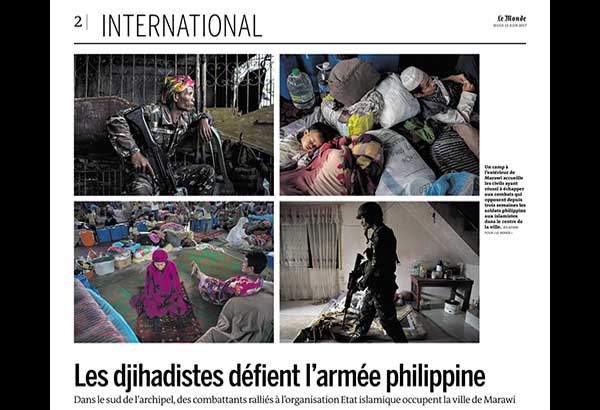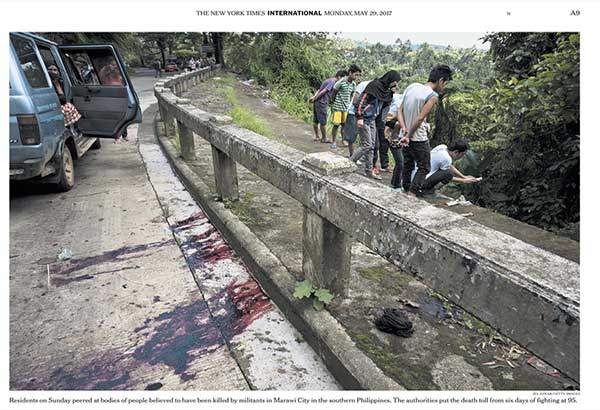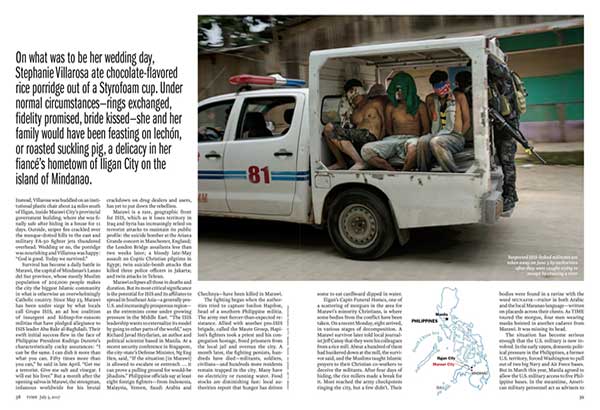FEATURE STORY:Behind The Lens: Jes Aznar

Images courtesy of JEZ AZNAR
MANILA, Philippines - As a photojournalist, Jes Aznar faces danger every day — whether it’s covering the clashes in Marawi, or coming under fire from keyboard warriors. Just last month, Thinking Pinoy blogger RJ Nieto falsely accused him of revealing Philippine soldiers’ positions through videos posted on Instagram.
But instead of allowing threats from angry netizens to get to him, Jes soldiers on, and his hard work has paid off. His coverage of the Marawi siege landed on the cover of Time magazine’s July 3, 2017 issue. He is also a contract photographer for international publications like The New York Times and The Wall Street Journal. Here, he talks to Supreme about the nature of his work, the role social media plays in it, and dealing with trolls.

SUPREME: When you’re covering conflicts like the siege of Marawi, what does it look like?
JES AZNAR: The siege of Marawi is unprecedented in the country. I have never covered anything like this in my career as a photojournalist. For some journalists, it is always better to go in big groups for safety. But there are some who prefer to go in small groups like we did. Those who have the proper gear and training try to follow soldiers on patrol or to their deployment areas. There are also some who stay in the provincial capitol to wait for announcements and press briefings.
There must be so much going on at once. How do you get a good shot in the midst of all the chaos? How do you decide which moments to capture?
Taking good shots under pressure takes years of practice, and knowing which shot to take depends on how well you know what you are covering. Pressure is something photojournalists have to deal with every day and in each assignment. It only takes a fraction of a second to capture the actual moment and then it’s gone forever and you cannot get a second take.
How do you stay safe while shooting in war-torn areas?
Always keep in mind that there is no story or picture that is worth your life.

The soldiers often say we are so brave to be going to the frontline of battle just to take pictures. I just tell them it has nothing to do with bravery, as I am honestly scared. Being scared while covering a hostile situation for me is a good thing. It keeps me from doing stupid things I will later regret or, worse, get me killed. I think presence of mind is more useful than bravery in these kinds of situations.
If you will cover such situations, you should undergo a Hostile Environment and First Aid Training at the least.
Are there certain protocols you have to follow while covering conflict?
I guess it depends on the situation, place, the units you are with, and their activity. But generally, you shouldn’t do anything that will put the unit you’re with in danger, as you will be putting yourself in danger as well. So be mindful of every step and action you take.
Colleagues who have had the chance of embedding with the US military in the wars in the Middle East for a long time say that everything was organized from embedding procedures to bunk beds that you will sleep in inside the base. And the units don’t care what you write or take pictures of as long as you don’t get in the way of their operation.

How do you deal with the emotional toll of covering the drug war and the siege of Marawi?
Those who cover traumatic events don’t notice at first, but eventually, the emotional and mental toll will catch up with you. Every person has a different tolerance and different ways of processing traumatic events. Because our work is non-stop, we sometimes do not notice it, and most of the time take it for granted. For example, it took a year before the signs and manifestations of stress and trauma from the three-month-long coverage of the aftermath of Typhoon Haiyan kicked in for me. I was so sick and depressed for months. The PECOJON (Peace and Conflict Journalists Network) sessions on trauma and healing years before helped me understand what was going on with me, and I reached out for help.
One has to deal with it sooner or later. No one is invincible.
What role does social media play in your work?
I guess social media is a great tool, but I’m still trying to figure out how it can help me, particularly with my professional work. But for its general use, Instagram has been great, especially for our personal projects like the @everydayphilippines page that we set up, and it continues to be successful. On the side of advocacy for human rights, we are now also setting up @everydayimpunity to show stories of the alarming culture of impunity the country has had for decades. And these pages have the support of an ever-growing global community of @everyday pages with millions of followers.
How did you deal with being attacked by trolls after Rey Joseph Nieto’s posts?
I guess the same way anybody should handle fake news, just ignore.
After everything that’s happened with The Thinking Pinoy, do you feel vindicated after your photo was used on the cover of Time magazine?
Honestly, I don’t know how to connect the two. But vindication? No. I mean, it is not necessary. I’m just doing my job taking that picture, and I’d still be doing that with or without these detractors. Apparently, their gripe is with The New York Times, and later on with Time magazine, and Washington Post, etc. —basically every reputable international publication that has something to do with publishing reports something that their principal doesn’t agree with — or the media in general. So they use social media to try to discredit these publications. But unfortunately for them, most of these publications were built on time-proven integrity, long before they were even born. So it will be hard for them to make their case.
As for me, I have been working for international publications for more than a decade and my audience is global. Their principal is just a small fraction of the topics that I cover. Sure, people have their own biases; so be it. But since they are public figures, if they are doing something wrong or anything at all, my job is not to argue with them, but to take pictures and present stories of the truth. What significance do I have to be the story? None. So I’ll just leave them be and just do my job.
I just felt sad. Sad because there is this small group of people in the Philippines who still don’t understand the work of photojournalists. It’s telling of many things, quite frankly.
What struck you the most while covering Marawi?
It struck everybody there that what happened in Marawi is unprecedented and unthinkable. What struck me is the fear of having more of these kinds of attacks and the consequences they would have for the people. For us.
What would you say is the most rewarding part of your job?
I think the most rewarding part of this job would be the moment you know your pictures helped someone. It may be for being informed, or for being enlightened, or moved, or for people to act and do something, or for those in power to act and help those affected in your pictures. That is the most rewarding part of any photojournalist’s job.
* * *
Follow Jes Aznar’s work on Instagram: @jeszmann.















